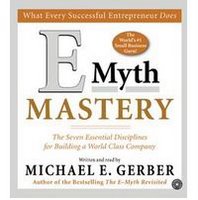 Recently, our firm had the opportunity to strengthen its approach to performing business research. Given the fact that we are committed to documenting the way we do business (a la “The eMyth”) and in sharing as much of it as possible for others to use, I thought that I should start to do it in this blog.
Recently, our firm had the opportunity to strengthen its approach to performing business research. Given the fact that we are committed to documenting the way we do business (a la “The eMyth”) and in sharing as much of it as possible for others to use, I thought that I should start to do it in this blog.
The end result of doing this revamp was that we created a method that gave us a surprising set of insights and understanding.
At the outset, I should say that I have found business research to be boring as hell. And I say this from experience – I teach the damned subject in the University of Phoenix business school.
To be honest, my students usually don’t find it boring. Instead, they are usually found complaining about how difficult the material is! Fear of not doing well overcomes ennui any day.
With that in mind, I took the lead in designing an approach that seemed to make sense for the kind of research that our firm is called on to do here in the region. Given that we focus exclusively on solving difficult people problems that impact the bottom line, it seems fitting that research studies that involve people would be a natural part of what we do.
Furthermore, our firm’s tagline is “High Stake Interventions” which means that we should be doing the kind of research that makes an unforgettable impact, whether it is actually implemented as we recommend or not. It definitely should not produce a run-of-the mill set of outputs.
Furthermore, given our focus on people, our approach should account for the relatively low levels of education found in parts of the region, and some of the cultural nuances we have come across. In some companies, employees are not functionally literate, let alone computer literate. Also, many are wary of completing surveys, no matter what the guarantee is of anonymity.
The Opening Bias
It might be fair to say that most business research takes place in the form of employee surveys.
The research firm tackles the assignment with no biases or predispositions, with no pre-set agenda.
Our research is quite different.
It starts with a focused question, concern or issue. It ends with a clear answer, new mental models and a framework designed for action.
In this respect, it is an important part of what we deliver – High Stake Interventions – and quite different from opinion surveys (although survey instruments might be included.) The difference begins with the need to decisively answer a Single Question that is of concern. Diving into the Single Question may lead to the raising of others, but they are incidental to the main point.
Coming up with Single Question sometimes involves several clarifying as the client management itself is often not clear on what it wants.
Example questions might include:
- what is the source of low employee motivation?
- why is the CEO disliked?
- Is the foreign ownership of the company a major problem?
- Why are employees not referring our company’s products and services to others?
- Why is there no evidence of the culture we want to create?
These questions are not easy ones to answer, and when they must still be answered the wise executive can sometimes see the need to bring in outside help to give an objective point of view.
Yet, at the same time this is not about discovering some scientific truth. Instead, in our research we bring along our prior understanding and experience, and fully understand that that the very process of asking probing questions by itself changes the answers that are given. Ultimately, the kind of research we do is about attitudes and perceptions, and they are not amenable to perfect scientific measurement.
Mind Mapping
Once the Single Question is defined, a Mind Map is constructed to bring together all of the related issues into a single place. This act of “emptying the mind” is a powerful, nonlinear way to brainstorm. The result is a diagram showing how issues and sub-issues are woven together and linked to each other. Click here for a link to mind mapping.
Early Answer
From the gestalt of connected pieces of information on the Mind Map, the team can develop an initial hypothesis, or early answer. This is given in the form of a complete solution or answer to the Single Question, as if the data that is known at this point were all the information that could be known.
This initial hypothesis is held in the background as a possible solution, and is only discarded when there is clear evidence that it is incorrect. At that point, a new early answer is developed to replace the old, and that one is treated in the same manner until the project comes to a close, and the final hypothesis is the one that the final recommendations are built around.
Issue Tree
The completion of the map makes it possible to begin the linear process of analyzing the issues and sub-issues.
The initial question is broken down into a possible set of answers, and sub-answers.
For example, the question: Is the machine functioning? Can be answered with the following answers and sub-answers:
Is the machine functioning?
– Yes
– No
– It needs lubrication
– It must be overhauled
– The power source is corrupt
Furthermore, each answer can be broken down into several sub-answers. For example, “It needs lubrication” can be further broken down into other options such as “Use grease on joints” and “Use a light oil on pressure points.”
The questions and answers are brought together into a single diagram to create an Issue Tree that shows the important lines of inquiry to be explored. If a team is to be involved in the project, then the issue tree is divided up among the team members who each are accountable for ensuring that the correct data is gathered to answer their assigned issue. In this way, they are the “experts” on the project with respect to that issue. See a link here to a description to Issue Trees.
Questionnaires and Surveys
The next step in our methodology is to convert the branches of the tree into questions that can be asked in interviews, surveys and focus groups. At this point, it is important that the questions be worded in a way that the responses precisely match the data requirements of the issue tree. At this step, regional differences need to be brought into play, as standard English plus local dialect are used to convey the exact meaning and sentiment.
If a team is involved in gathering the data, then each member must be “trained” in seeking out the right kind of data required to meet the needs of the research team.
We use a multi-faceted approach to gather the information required. There are cultural and logistical limits to using any single approach to the exclusion of others, and a combination of approaches helps to balance out the quality of information gathered.
Sharing Data
Given the fact that the interviews are usually not conducted by the full research team, then the data must somehow be shared among team-members. Our firm’s practice is to electronically scan and share notes through a wiki web-site. In this way, each team member can have at their finger-tips all the written notes taken from each interview. In the future, we hope to expand the data sharing options to include voice-based files.
Secondary Data
Once the primary data is gathered using the methods described above, we perform secondary data searches using sources in libraries and the internet. Knowledge of how to conduct searches on Google, in the blogosphere and through human networks of regional contacts are all critical to finding information that is timely and relevant, but also credible.
Analysis
Each team member uses the data gathered to help answer the questions in the branch of the issue tree for which they are responsible. They also use pertinent data from secondary research if possible to “prove” the final answer to the team.
This ”proving” conversation marks the start of the portion of the project that is probably the most creative.
The basic evidence that is gathered is presented, and the team starts to assemble a framework that can hold both new data being gathered on the project, and data from past experience. This creative process is a unique one that pushes the team in a search for more and more effective ways to answer the single question, and address the contents of the issue tree.
The method ensures that the framework developed is one that the company can use if the situation is ever repeated under similar circumstances.
Report Writing
The final report is, at its heart, a teaching document meant to persuade the reader that the recommended course of action is the one that will yield the greatest results. In this sense, it does not follow the academic method of report writing that I teach in my classes. Our reports would not get an A in a research methods class, and that is because we are not trying to meet academic requirements.
In our approach, however, the real value lies in the frameworks that we create. They are designed along the following guidelines:
n they must be memorable, and easy to pass on
n they must be simple
n they must be based on the data that has been collected
n they must pass the test of common-sense
The frameworks we build also have a heavy intuitive component, and rely on a blend of experience and insight for their creation. New phrases, distinctions and terms are freely created to avoid the concepts being presented to fall into old mental models that prevent our clients from seeing the problem and solutions in a new way.
For example, we created the term “emotional workplace maturity” to explain why the behaviour of a foreign owned company was so different from the behaviour found in the home country. This new definition helped to drive home the need for new and different ways of preparing managers from the home country to cope, and also helped the owners to see why programs they had used with great effect back home were not working.
Summary
Our method is designed to be a form of intervention, rather than an example of business research. Given the fact that we are looking at opinions, culture and attitudes in order to help solve business problems, our focus is on what will make a difference when the recommendations are implemented, and the new frameworks have begun to be used.
Notes: our approach is built in part on the method described in “The McKinsey Way” by Ethan Rasiel.
A great summary of the book is found here.
 Jeff Thull’s book “Exceptional Selling” on the art of conducting High Stakes Sales continues to provide superior value. He has written several articles for management consultants that I have found particularly useful.
Jeff Thull’s book “Exceptional Selling” on the art of conducting High Stakes Sales continues to provide superior value. He has written several articles for management consultants that I have found particularly useful.





